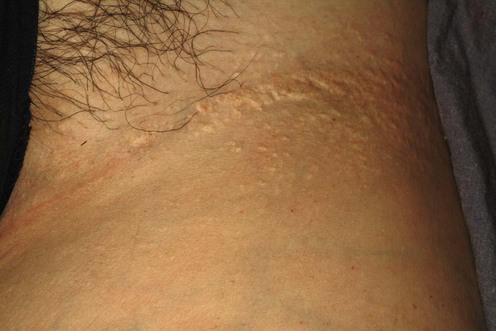Pseudoxanthoma elasticum

Specific investigations
The tests are expensive and rarely essential to confirm the diagnosis.
Pseudoxanthoma elasticum.
Neldner KH. Clin Dermatol 1988; 6: 1–159.
For the interested physician, patients, or their families, this is the only book devoted solely to PXE. It is out of print from the publisher but can be obtained in paperback with full color clinical photos from the National Association for PXE, 8760 Manchester Road, St Louis, MO 64144–2724; email: NAPEstlouis@sbcglobal.net.







 Thorough discussion of PXE with the patient and family, stressing the importance of lifelong follow-up and potential complications
Thorough discussion of PXE with the patient and family, stressing the importance of lifelong follow-up and potential complications Attention to current PXE medical literature for new therapies
Attention to current PXE medical literature for new therapies Good nutrition; avoidance of trans fats; dietary calcium intake based on patient age and the current recommended dietary intake
Good nutrition; avoidance of trans fats; dietary calcium intake based on patient age and the current recommended dietary intake Regular exercise program, with care to avoid sports with potential for head or eye injury
Regular exercise program, with care to avoid sports with potential for head or eye injury Vigorous control of hypertension and abnormal lipid profiles
Vigorous control of hypertension and abnormal lipid profiles Avoid long-term use of anticoagulants (gastrintestinal bleeding)
Avoid long-term use of anticoagulants (gastrintestinal bleeding) Retinal referral and follow-up on regular basis with a retinal specialist familiar with PXE. If early or threatened retinal hemorrhages, check for possible treatment with bevacizumab (Avastin) or ranibizumab (Lucentis)
Retinal referral and follow-up on regular basis with a retinal specialist familiar with PXE. If early or threatened retinal hemorrhages, check for possible treatment with bevacizumab (Avastin) or ranibizumab (Lucentis) Consider cardiology referral for signs of mitral valve prolapse
Consider cardiology referral for signs of mitral valve prolapse Referral to cosmetic surgeon for removal of objectionable lesions if desired by patient for cosmetic reasons
Referral to cosmetic surgeon for removal of objectionable lesions if desired by patient for cosmetic reasons Observe pregnant women more carefully. Incidence of gastrointestinal hemorrhage is questionably increased during pregnancy
Observe pregnant women more carefully. Incidence of gastrointestinal hemorrhage is questionably increased during pregnancy Encourage the patient and their family to follow the medical literature available on PXE at various computer sites. Provide information on joining one or both PXE support groups: National Association for PXE (NAPE) and PXE International. Check the internet for websites and details on updates regarding new therapies
Encourage the patient and their family to follow the medical literature available on PXE at various computer sites. Provide information on joining one or both PXE support groups: National Association for PXE (NAPE) and PXE International. Check the internet for websites and details on updates regarding new therapies Sevelamer hydrochloride 800 mg three times daily
Sevelamer hydrochloride 800 mg three times daily Increase in dietary magnesium
Increase in dietary magnesium